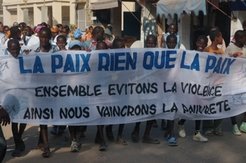Conflict and integration in the Basse Casamance, Senegal
Background information
The Casamance, a small stretch of fertile land between The Gambia and Guinea-Bissau is usually portrayed as an economically promising part of a well-governed Senegalese democracy. If ever, the conflict in this southern part of Senegal – which started 25 years ago – is only mentioned in terms of it lasting longer than any other such conflict in Africa. It has had a heavy death toll and caused major political disruptions in the region. In the course of the war a total of 3,000-5,000 people have been killed, 65,000 are estimated to be displaced and unmapped mine fields make for another ca. 650 victims. Even two years after the last “final” peace accord was signed by the militant rebel movement MFDC (Mouvement des forces dèmocratiques de la Casamance) and the Senegalese state, more than 10,000 people were in the act of trying to escape skirmishes on the border to The Gambia in 20061.

Situated between the Sahel and the Upper Guinea Coast region, the Casamance has always been a crossroad of cultures. There have been multiple attempts to enslave, colonise, convert and civilise the inhabitants of the Casamance by various groups from outside the region. Despite these continuous attempts to integrate this frontier region into the campaigns of islamisation, French colonisation and Senegalese modernization the Casamance was only marginally influenced by these respective projects. It is said to be ethnically, religiously, socially and economically distinct from the northern part of the country2. Its geographical isolation contributed to its “cut off” and historically quite independent status.
An independence movement emerged in 1982, demanding sovereignty on the basis of this historical and cultural differences. The movement for independence – centred mainly in the Basse Casamance (Ziguinchor region) – soon took up arms and started a guerrilla war. Today the local situation is characterized by the diversity of groups participating in the conflict and the repeated failure of cease fires and peace talks to stop it. On the other hand, the region is experiencing out-migration to the capital; there in Dakar a significant percentage of public employees, police and military personnel are from the Casamance, thus connecting this “peripherical” region to the centre.
Theoretical premises
As conflict theory has shown, violent actors in conflicts tend to act rationally in many ways. In order to survive in a market of violence they need to manage resources (arms, soldiers, fear, etc.) in the most profitable way. To stick to these “rules of the game” might cause a self-perpetuating vicious circle. On the other hand, the social organisation of conflict is linked directly to the strength of societal incorporation as such. This means that integration can be achieved by means of equal access to justice. Common procedures to resolve conflicts without violence strengthen social cohesion and identities (– i.e. the community of citizens in ancient Rome differentiated themselves from non-Romans most clearly by their right to be judged according to Roman law).
Theory concerning the social construction of identity has furthermore pointed out that »we« and »others« are indispensable categories in the construction of social identity and difference. It has also been demonstrated that identities are – to different degrees – flexible and alterable (including ethnic affiliation).
From this findings it follows that one of the dialectics of conflict is that they can trigger rapid social change in the very socio-cultural matrices (to a certain extent) they are confined to. New group identities are likely to evolve while the conflict itself rests on the precondition that conflicting groups and the attributed fixed identities of their members be differentiable. In other words, the boundaries between “us” and “them” both make the conflict possible and facilitate its modification. Therefore, the understanding of conflicts rests on the understanding of the strategies and reasoning of identification.
1 Irinnews.org: SENEGAL: No end to region’s longest-running war, 11.12.2006 and: Evans, M. (2004). Sénégal: Mouvement Des Forces Démocratiques de la Casamance (MFDC), The Royal Institute of International Affaires.
2 Ethnically: Jola-majority in the Casamance versus a Wolof-majority in the rest of Senegal; religiously: percentage of Christians and animists is higher than the national average; socially: segmentary, egalitarian Casamancais structure differs from a more hierarchical order in the north; economically: village-based rice farming predominates in the Casamance whereas modern groundnut and cotton production characterize agriculture in the north.
